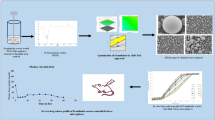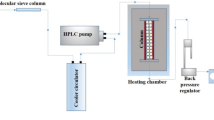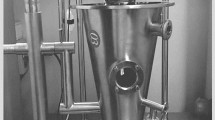Abstract
Risedronate sodium (RS) is a potent inhibitor of bone resorption, having an extreme poor permeability and limited oral bioavailability (0.62%). RS should be orally administered under fasting conditions while keeping in an upright posture for at least 30 min to diminish common gastroesophageal injuries. To surmount such limitations, novel risedronate–chitosan (RS–CS) crosslinker-free nebulizable microspheres were developed adopting the quality by design (QbD) approach and risk assessment (RA) thinking. RS:CS ratio, surfactant (Pluronic® F127) concentration, homogenization duration, speed, and temperature were identified using Ishikawa diagrams as the highest formulation and process risk factors affecting the critical quality attributes (CQAs), average particle size (PS), and entrapment efficiency (EE%). The risk factors were screened using the Plackett–Burman design, and the levels of the most significant factors were optimized using a multilevel factorial design to explore the optimized system with the least PS, maximum EE%, and a prolonged drug release profile. The optimized system (B6) was developed at a RS:CS ratio of 1:7, a surfactant concentration of 2% (w/v), and a homogenization speed of 14,000 rpm. It revealed good correlation with QbD theoretical prediction, where positively charged (47.9 ± 3.39 mV) discrete, spherical microspheres (3.47 ± 0.16 μm) having a high EE% (94.58 ± 0.19%) and prolonged RS release over 12 h (Q12 h, 89.70 ± 0.64%) were achieved. In vivo lung deposition after intratracheal instillation of B6 confirmed the delivery of high RS percentage to rat lung tissues (87 ± 3.54%) and its persistence for 24 h. This investigation demonstrated the effectiveness of QbD philosophy in developing RS–CS crosslinker-free nebulizable microspheres.









Similar content being viewed by others

References
Pilcer G, Wauthoz N, Amighi K. Lactose characteristics and the generation of the aerosol. Adv Drug Deliv Rev. Elsevier. 2012;64:233–56.
Tan Y, Yang Z, Pan X, Chen M, Feng M, Wang L, et al. Stability and aerosolization of pressurized metered dose inhalers containing thymopentin nanoparticles produced using a bottom-up process. Int J Pharm. Elsevier. 2012;427:385–92.
Kaialy W, Ticehurst M, Nokhodchi A. Dry powder inhalers: mechanistic evaluation of lactose formulations containing salbutamol sulphate. Int J Pharm. Elsevier. 2012;423:184–94.
Wu L, Miao X, Shan Z, Huang Y, Li L, Pan X, et al. Studies on the spray dried lactose as carrier for dry powder inhalation. Asian J Pharm Sci. Elsevier. 2014;9:336–41.
Fleisch H. Prospective use of bisphosphonates in osteoporosis. J Clin Endocrinol Metab. Oxford University Press. 1993;76:1397–8.
Ueno M, Maeno T, Nishimura S, Ogata F, Masubuchi H, Hara K, et al. Alendronate inhalation ameliorates elastase-induced pulmonary emphysema in mice by induction of apoptosis of alveolar macrophages. Nat Commun. Nature Publishing Group. 2015;6:6332.
Panderi I, Taxiarchi E, Pistos C, Kalogria E, Vonaparti A, Panderi I, et al. Insights into the mechanism of separation of bisphosphonates by zwitterionic hydrophilic interaction liquid chromatography: application to the quantitation of risedronate in pharmaceuticals. Separations. Multidisciplinary Digital Publishing Institute. 2019;6:6.
Guzman ML, Soria EA, Laino C, Manzo RH, Olivera ME. Reduced food interaction and enhanced gastrointestinal tolerability of a new system based on risedronate complexed with Eudragit E100: mechanistic approaches from in vitro and in vivo studies. Eur J Pharm Biopharm. Elsevier. 2016;107:263–72.
Peter CP, Handt LK, Smith SM. Esophageal irritation due to alendronate sodium tablets: Possible mechanisms. Dig Dis Sci. 1998;43:1998–2002.
Nasr M, Awad GAS, Mansour S, Taha I. Shamy A Al, Mortada ND. Different modalities of NaCl osmogen in biodegradable microspheres for bone deposition of risedronate sodium by alveolar targeting. Eur J Pharm Biopharm. Elsevier. 2011;79:601–11.
Papapetrou PD. Bisphosphonate-associated adverse events. Hormones (Athens). 2009;8:96–110.
Nasr M, Taha I, Hathout RM. Suitability of liposomal carriers for systemic delivery of risedronate using the pulmonary route. Drug Deliv. Taylor & Francis. 2013;20:311–8.
Ezra A, Golomb G. Administration routes and delivery systems of bisphosphonates for the treatment of bone resorption. Adv Drug Deliv Rev. Elsevier. 2000;42:175–95.
Blumentals WA, Harris ST, Cole RE, Huang L, Silverman SL. Risk of severe gastrointestinal events in women treated with monthly ibandronate or weekly alendronate and risedronate. Ann Pharmacother. SAGE PublicationsSage CA: Los Angeles, CA. 2009;43:577–85.
Fazil M, Hassan MQ, Baboota S, Ali J. Biodegradable intranasal nanoparticulate drug delivery system of risedronate sodium for osteoporosis. Drug Deliv. Taylor & Francis. 2016;23:2428–38.
Pazianas M, Abrahamsen B, Ferrari S, Russell RGG. Eliminating the need for fasting with oral administration of bisphosphonates. Ther Clin Risk Manag. Dove Press. 2013;9:395–402.
Kim JS, Jang SW, Son M, Kim BM, Kang MJ. Enteric-coated tablet of risedronate sodium in combination with phytic acid, a natural chelating agent, for improved oral bioavailability. Eur J Pharm Sci. 2016;82:45–51.
Nam SH, Jeong J-H, Che X, Lim K-E, Nam H, Park J-S, et al. Topically administered risedronate shows powerful anti-osteoporosis effect in ovariectomized mouse model. Bone. 2012;50:149–55.
Park J-H, Jin H-E, Kim D-D, Chung S-J, Shim W-S, Shim C-K. Chitosan microspheres as an alveolar macrophage delivery system of ofloxacin via pulmonary inhalation. Int J Pharm. Elsevier. 2013;441:562–9.
Oyarzun-Ampuero FA, Brea J, Loza MI, Torres D, Alonso MJ. Chitosan–hyaluronic acid nanoparticles loaded with heparin for the treatment of asthma. Int J Pharm. Elsevier. 2009;381:122–9.
Teijeiro-Osorio D, Remuñán-López C, Alonso MJ. Chitosan/cyclodextrin nanoparticles can efficiently transfect the airway epithelium in vitro. Eur J Pharm Biopharm. Elsevier. 2009;71:257–63.
Debnath SK, Saisivam S, Debanth M, Omri A. Development and evaluation of chitosan nanoparticles based dry powder inhalation formulations of prothionamide. Fraceto L, editor. PLoS One. Public Library of Science. 2018;13:e0190976.
Foda NH, El-Laithy HM, Tadros MI. Implantable biodegradable sponges: effect of interpolymer complex formation of chitosan with gelatin on the release behavior of tramadol hydrochloride. Drug Dev Ind Pharm. 2007;33:7–17.
Badawi AA, El-Laithy HM, El Qidra RK, El Mofty H, El Dally M. Chitosan based nanocarriers for indomethacin ocular delivery. Arch Pharm Res. 2008;31:1040–9.
Pearlman O. Reviewing the use of glutaraldehyde for high-level disinfection by sonographers. J Diagnostic Med Sonogr. 2019;35:49–57.
Takigawa T, Endo Y. Effects of glutaraldehyde exposure on human health. J Occup Health. 2006;48:75–87.
Bhattarai N, Gunn J, Zhang M. Chitosan-based hydrogels for controlled, localized drug delivery. Adv Drug Deliv Rev. Elsevier. 2010;62:83–99.
Yu LX, Amidon G, Khan MA, Hoag SW, Polli J, Raju GK, et al. Understanding pharmaceutical quality by design. AAPS J. Springer US. 2014;16:771–83.
Karimi K, Pallagi E, Szabó-Révész P, Csóka I, Ambrus R. Development of a microparticle-based dry powder inhalation formulation of ciprofloxacin hydrochloride applying the quality by design approach. Drug Des Devel Ther. Dove Press. 2016;10:3331–43.
Amasya G, Badilli U, Aksu B, Tarimci N. Quality by design case study 1: design of 5-fluorouracil loaded lipid nanoparticles by the W/O/W double emulsion - solvent evaporation method. Eur J Pharm Sci. Elsevier. 2016;84:92–102.
Buttini F, Rozou S, Rossi A, Zoumpliou V, Rekkas DM. The application of quality by design framework in the pharmaceutical development of dry powder inhalers. Eur J Pharm Sci. Elsevier. 2018;113:64–76.
Simões A, Veiga F, Vitorino C, Figueiras A. A Tutorial for Developing a Topical Cream Formulation Based on the Quality by Design Approach. J Pharm Sci. Elsevier. 2018;107:2653–62.
Gyulai O, Kovács A, Sovány T, Csóka I, Aigner Z. Optimization of the critical parameters of the spherical agglomeration crystallization method by the application of the Quality by Design approach. Materials (Basel). Multidisciplinary Digital Publishing Institute (MDPI). 2018;11:635.
Benjasirimongkol P, Piriyaprasarth S, Moribe K, Sriamornsak P. Use of risk assessment and Plackett–Burman design for developing resveratrol spray-dried emulsions: a quality-by-design approach. AAPS PharmSciTech. 2019;20:14.
Kuzmov A, Minko T. Nanotechnology approaches for inhalation treatment of lung diseases. J Control Release. Elsevier. 2015;219:500–18.
El-Sherbiny IM, El-Baz NM, Yacoub MH. Inhaled nano- and microparticles for drug delivery. Glob Cardiol Sci Pract. Bloomsbury Qatar Foundation Journals Qatar. 2015;2015:2.
Shah B, Khunt D, Bhatt H, Misra M, Padh H. Application of quality by design approach for intranasal delivery of rivastigmine loaded solid lipid nanoparticles: effect on formulation and characterization parameters. Eur J Pharm Sci. Elsevier B.V. 2015;78:54–66.
Yerlikaya F, Ozgen A, Vural I, Guven O, Karaagaoglu E, Khan MA, et al. Development and evaluation of paclitaxel nanoparticles using a quality-by-design approach. J Pharm Sci. Elsevier. 2013;102:3748–61.
Pallagi E, Karimi K, Ambrus R, Szabó-Révész P, Csóka I. New aspects of developing a dry powder inhalation formulation applying the quality-by-design approach. Int J Pharm. Elsevier. 2016;511:151–60.
Pandey AP, Karande KP, Sonawane RO, Deshmukh PK. Applying quality by design (QbD) concept for fabrication of chitosan coated nanoliposomes. J Liposome Res. Taylor & Francis. 2014;24:37–52.
Ahmed OAA, Kurakula M, Banjar ZM, Afouna MI, Zidan AS. Quality by design coupled with near infrared in formulation of transdermal glimepiride liposomal films. J Pharm Sci. 2015;104:2062–75.
Ćurić A, Reul R, Möschwitzer J, Fricker G. Formulation optimization of itraconazole loaded PEGylated liposomes for parenteral administration by using design of experiments. Int J Pharm. Elsevier. 2013;448:189–97.
Xu X, Khan MA, Burgess DJ. A quality by design (QbD) case study on liposomes containing hydrophilic API: II. Screening of critical variables, and establishment of design space at laboratory scale. Int J Pharm. Elsevier. 2012;423:543–53.
Park S-J, Choo G-H, Hwang S-J, Kim M-S. Quality by design: screening of critical variables and formulation optimization of Eudragit E nanoparticles containing dutasteride. Arch Pharm Res. 2013;36:593–601.
Calvo P, Remuñán-López C, Vila-Jato JL, Alonso MJ. Novel hydrophilic chitosan-polyethylene oxide nanoparticles as protein carriers. J Appl Polym Sci. 1997;63:125–32.
Mennini N, Furlanetto S, Cirri M, Mura P. Quality by design approach for developing chitosan-Ca-alginate microspheres for colon delivery of celecoxib-hydroxypropyl-β-cyclodextrin-PVP complex. Eur J Pharm Biopharm. 2012;80:67–75.
Solaiman A, Suliman AS, Shinde S, Naz S, Elkordy AA. Application of general multilevel factorial design with formulation of fast disintegrating tablets containing croscarmellose sodium and Disintequick MCC-25. Int J Pharm. Elsevier. 2016;501:87–95.
Cook RO, Pannu RK, Kellaway IW. Novel sustained release microspheres for pulmonary drug delivery. J Control Release. Elsevier. 2005;104:79–90.
Salama RO, Traini D, Chan H-K, Young PM. Preparation and characterisation of controlled release co-spray dried drug–polymer microparticles for inhalation 2: evaluation of in vitro release profiling methodologies for controlled release respiratory aerosols. Eur J Pharm Biopharm. Elsevier. 2008;70:145–52.
Tadros MI, Al-mahallawi AM. Long-circulating lipoprotein-mimic nanoparticles for smart intravenous delivery of a practically-insoluble antineoplastic drug: development, preliminary safety evaluations and preclinical pharmacokinetic studies. Int J Pharm. Elsevier. 2015;493:439–50.
Tayel SA, El-Nabarawi MA, Tadros MI, Abd-Elsalam WH. Duodenum-triggered delivery of pravastatin sodium via enteric surface-coated nanovesicular spanlastic dispersions: development, characterization and pharmacokinetic assessments. Int J Pharm. 2015;483:77–88.
Stubbs C, Haigh JM, Kanfer I. Determination of erythromycin in serum and urine by high-performance liquid chromatography with ultraviolet detection. J Pharm Sci. 1985;74:1126–8.
Fan Y, Shan-Guang W, Yu-Fang P, Feng-Lan S, Tao L. Preparation and characteristics of erythromycin microspheres for lung targeting microspheres of erythromycin for lung targeting. Drug Dev Ind Pharm. 2009;35:639–45.
Pellosi DS, d’Angelo I, Maiolino S, Mitidieri E, d’Emmanueledi Villa Bianca R, Sorrentino R, et al. In vitro/in vivo investigation on the potential of Pluronic® mixed micelles for pulmonary drug delivery. Eur J Pharm Biopharm. Elsevier. 2018;130:30–8.
Kyriakides D, Panderi I. Development and validation of a reversed-phase ion-pair high-performance liquid chromatographic method for the determination of risedronate in pharmaceutical preparations. Anal Chim Acta. Elsevier. 2007;584:153–9.
Das SK, Khanam J, Nanda A. Optimization of preparation method for ketoprofen-loaded microspheres consisting polymeric blends using simplex lattice mixture design. Mater Sci Eng C. Elsevier B.V. 2016;69:598–608.
Kang ML, Jiang H-L, Kang SG, Guo DD, Lee DY, Cho C-S, et al. Pluronic® F127 enhances the effect as an adjuvant of chitosan microspheres in the intranasal delivery of Bordetella bronchiseptica antigens containing dermonecrotoxin. Vaccine. Elsevier. 2007;25:4602–10.
Vithani K, Hawley A, Jannin V, Pouton C, Boyd BJ. Inclusion of digestible surfactants in solid SMEDDS formulation removes lag time and influences the formation of structured particles during digestion. AAPS J. Springer US. 2017;19:754–64.
Heiskanen H, Denifl P, Pitkänen P, Hurme M. Effect of preparation conditions on the properties of microspheres prepared using an emulsion-solvent extraction process. Chem Eng Res Des. Elsevier. 2012;90:1517–26.
Khan MF, Ansari AH, Hameedullah M, Ahmad E, Husain FM, Zia Q, et al. Sol-gel synthesis of thorn-like ZnO nanoparticles endorsing mechanical stirring effect and their antimicrobial activities: Potential role as nano-antibiotics. Sci Rep. Nature Publishing Group. 2016;6:27689.
Yuan D, Jacquier JC, O’Riordan ED. Entrapment of protein in chitosan-tripolyphosphate beads and its release in an in vitro digestive model. Food Chem. Elsevier. 2017;229:495–501.
Moore T, Croy S, Mallapragada S, Pandit N. Experimental investigation and mathematical modeling of Pluronic® F127 gel dissolution: drug release in stirred systems. J Control Release. Elsevier. 2000;67:191–202.
He M, Wang H, Dou W, Chou G, Wei X, Wang Z. Preparation and drug release properties of norisoboldine-loaded chitosan microspheres. Int J Biol Macromol. Elsevier. 2016;91:1101–9.
Mohammed M, Syeda J, Wasan K, Wasan E. An overview of chitosan nanoparticles and its application in non-parenteral drug delivery. Pharmaceutics. 2017;9:53.
Ma L, Liu C. Preparation of chitosan microspheres by ionotropic gelation under a high voltage electrostatic field for protein delivery. Colloids Surf B: Biointerfaces. 2010;75:448–53.
Park JW, Byun Y. Ionic complex of risedronate with positively charged deoxycholic acid derivative: evaluation of physicochemical properties and enhancement of intestinal absorption in rats. Arch Pharm Res. Pharmaceutical Society of Korea. 2014;37:1560–9.
Jang SW, Lee JW, Ryu DS, Son M, Kang MJ. Design of pH-responsive alginate raft formulation of risedronate for reduced esophageal irritation. Int J Biol Macromol. Elsevier B.V. 2014;70:174–8.
Alishahi A, Mirvaghefi A, Tehrani MR, Farahmand H, Koshio S, Dorkoosh FA, et al. Chitosan nanoparticle to carry vitamin C through the gastrointestinal tract and induce the non-specific immunity system of rainbow trout (Oncorhynchus mykiss). Carbohydr Polym. Elsevier Ltd. 2011;86:142–6.
Ko JA, Park HJ, Hwang SJ, Park JB, Lee JS. Preparation and characterization of chitosan microparticles intended for controlled drug delivery. Int J Pharm. 2002;249:165–74.
Lin JH. Bisphosphonates: a review of their pharmacokinetic properties. Bone. 1996;18:75–85.
Bravo-Anaya LM, Soltero JFA, Rinaudo M. DNA/chitosan electrostatic complex. Int J Biol Macromol. Elsevier BV. 2016;88:345–53.
Rashid S, Shen C, Chen X, Li S, Chen Y, Wen Y, et al. Enhanced catalytic ability of chitosan-Cu-Fe bimetal complex for the removal of dyes in aqueous solution. RSC Adv. 2015;5:90731–41.
Bukzem AL, Signini R, dos Santos DM, Lião LM, Ascheri DPR. Optimization of carboxymethyl chitosan synthesis using response surface methodology and desirability function. Int J Biol Macromol. Elsevier. 2016;85:615–24.
Derringer G, Suich R. Simultaneous optimization of several response variables. J Qual Technol. Taylor & Francis. 1980;12:214–9.
El-Laithy HM, Badawi A, Abdelmalak NS, El-Sayyad N. Cubosomes as oral drug delivery systems: a promising approach for enhancing the release of clopidogrel bisulphate in the intestine. Chem Pharm Bull. 2018;66:1165–73.
Buratti C, Barbanera M, Lascaro E, Cotana F. Optimization of torrefaction conditions of coffee industry residues using desirability function approach. Waste Manag. Pergamon. 2018;73:523–34.
Ganesan P, Patil S, Pandey V, Shaju TM, Pothula S. A Practical Approach for Performing Multi-response Optimization for Advanced Process Control. Reliab Theory Appl. 2018;13:21–6.
Ritger PL, Peppas NA. A simple equation for description of solute release II. Fickian and anomalous release from swellable devices. J Control ReleaseElsevier. 1987;5:37–42.
El-Laithy HM, Nesseem DI, Shoukry M. Evaluation of two in situ gelling systems for ocular delivery of moxifloxacin: in vitro and in vivo studies. J Chem Pharm Res. 2011;3:66–79.
El-Laithy HM, Nesseem DI, El-Adly AA, Shoukry M. Moxifloxacin-gelrite in situ ophthalmic gelling system against photodynamic therapy for treatment of bacterial corneal inflammation. Arch Pharm Res. 2011;34:1663–78.
Sivadas N, O’Rourke D, Tobin A, Buckley V, Ramtoola Z, Kelly JG, et al. A comparative study of a range of polymeric microspheres as potential carriers for the inhalation of proteins. Int J Pharm. Elsevier. 2008;358:159–67.
Dhat S, Pund S, Kokare C, Sharma P, Shrivastava B. Risk management and statistical multivariate analysis approach for design and optimization of satranidazole nanoparticles. Eur J Pharm Sci. 2017;96:273–83.
Martinac A, Filipović-Grčić J, Voinovich D, Perissutti B, Franceschinis E. Development and bioadhesive properties of chitosan-ethylcellulose microspheres for nasal delivery. Int J Pharm. 2005;291:69–77.
Romić MD, Klarić MŠ, Lovrić J, Pepić I, Cetina-Čižmek B, Filipović-Grčić J, et al. Melatonin-loaded chitosan/Pluronic® F127 microspheres as in situ forming hydrogel: An innovative antimicrobial wound dressing. Eur J Pharm Biopharm. 2016;107:67–79.
Costa JR, Silva NC, Sarmento B, Pintado M. Potential chitosan-coated alginate nanoparticles for ocular delivery of daptomycin. Eur J Clin Microbiol Infect Dis. Springer. 2015;34:1255–62.
Peng H, Lin L, Ding G. Influences of primary particle parameters and surfactant on aggregation behavior of nanoparticles in nanorefrigerant. Energy. Elsevier Ltd. 2015;89:410–20.
Priyanka K, Sahu PL, Singh S. Optimization of processing parameters for the development of Ficus religiosa L. extract loaded solid lipid nanoparticles using central composite design and evaluation of antidiabetic efficacy. J Drug Deliv Sci Technol. Elsevier. 2018;43:94–102.
Yamamoto H, Kuno Y, Sugimoto S, Takeuchi H, Kawashima Y. Surface-modified PLGA nanosphere with chitosan improved pulmonary delivery of calcitonin by mucoadhesion and opening of the intercellular tight junctions. J Control Release. Elsevier. 2005;102:373–81.
Weers JG, Tarara TE, Clark AR. Design of fine particles for pulmonary drug delivery. Expert Opin Drug Deliv. 2007;4:297–313.
Grenha A, Al-Qadi S, Seijo B, Remuñán-López C. The potential of chitosan for pulmonary drug delivery. J Drug Deliv Sci Technol. Elsevier. 2010;20:33–43.
Lai C, Chen Y, Zhang S. Study on chitosan-lactate sponges with oriented pores as potential wound dressing. Mater Sci Appl. 2013;04:458–70.
Mukherjee D, Srinivasan B, Anbu J, Azamthulla M, Banala VT, Ramachandra SG. Improvement of bone microarchitecture in methylprednisolone induced rat model of osteoporosis by using thiolated chitosan-based risedronate mucoadhesive film. Drug Dev Ind Pharm. Taylor & Francis. 2018;44:1845–56.
Errassifi F, Sarda S, Barroug A, Legrouri A, Sfihi H, Rey C. Infrared, Raman and NMR investigations of risedronate adsorption on nanocrystalline apatites. J Colloid Interface Sci. 2014;420:101–11.
Author information
Authors and Affiliations
Corresponding author
Ethics declarations
The protocol of the study was reviewed and approved by the Research Ethics Committee (PI 1583) at the Faculty of Pharmacy, Cairo University (Cairo, Egypt).
Conflict of Interest
The authors declare that they have no conflict of interest.
Additional information
Publisher’s Note
Springer Nature remains neutral with regard to jurisdictional claims in published maps and institutional affiliations.
Rights and permissions
About this article
Cite this article
Elkady, O.A., Tadros, M.I. & El-laithy, H.M. QbD Approach for Novel Crosslinker-Free Ionotropic Gelation of Risedronate Sodium–Chitosan Nebulizable Microspheres: Optimization and Characterization. AAPS PharmSciTech 21, 14 (2020). https://doi.org/10.1208/s12249-019-1561-2
Received:
Accepted:
Published:
DOI: https://doi.org/10.1208/s12249-019-1561-2



